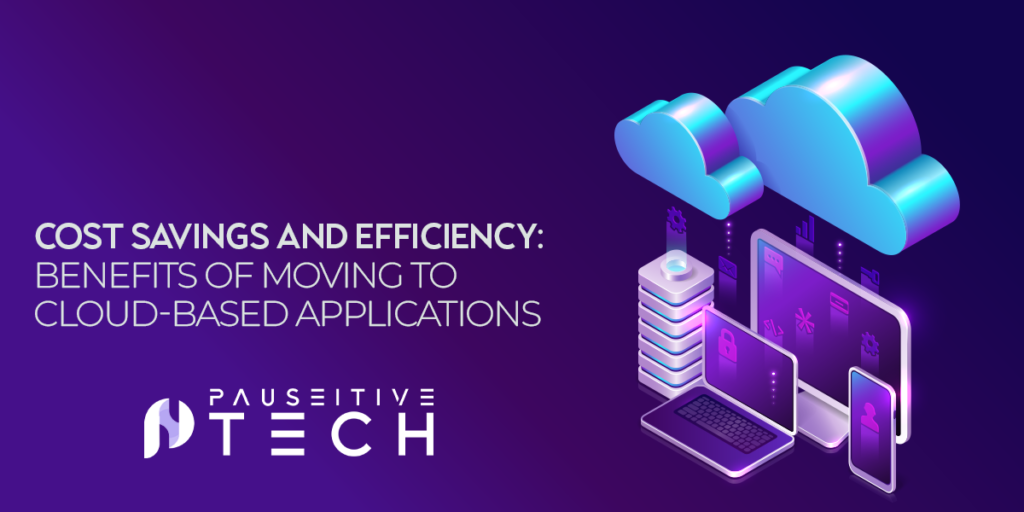In today’s highly competitive business environment, maneuvers, flexibility, and costs are vital prerequisites for success. This brings us to cloud computing, an innovative approach that is slowly revolutionizing the management of information technology in any establishment. Moving to the cloud will reveal that a world of opportunities exists out there, the advantage being, cost reduction and productivity being the most prominent.
Benefits of Moving to Cloud-Based Applications
This change in thinking from on-premise IT where the hardware and software components reside within an organization’s premises provides an attractive option. Cloud computing is the use of multiple interconnected and distributed remote servers that are accessed through the internet and available on an as-needed basis. This distributed model evens the playing field like nothing before for businesses of all sizes.

Let’s delve deeper into the cost-saving and efficiency benefits that cloud-based applications offer:
Reduced Capital Expenditure (CapEx):
IT infrastructure that resides on-premise calls for capital investment in hardware, software, and physical space to house all IT equipment. These costs can be a major impediment to a growing business or a business with fluctuating resource demands. Cloud computing does not require this kind of initial cost to be incurred, thereby making the entire process easy. This operational model is a cost-effective one since businesses only get billed for the resources they use, thus avoiding tying up capital in non-profit-making activities.
Optimized Operational Expenditure (OpEx):
The management and maintenance of the internal infrastructure of information technology systems is a demanding process in terms of resource utilization. Firms require professional IT personnel to handle physical technological assets, application upgrades, security fixes, and business continuity profiles. Cloud computing takes away this much pressure. The cloud provider is responsible for carrying out these tasks, thereby freeing up IT professionals to focus on other priorities that enhance organizational performance.
Automatic Scalability:
The deployment of cloud-based applications is exceptionally flexible and highly scalable. There are fluctuations in the magnitude or scale of resources that organizations can employ, depending on market forces. Scaling up and down depending on the level of activity at any one time is another advantage of cloud computing. On the other hand, during low sales or little traffic on the website, it is possible to scale down on usage of the resources hence reducing costs to business. This does not require extensive expenditures on over-provision of local IT infrastructure or sub-optimization in which a company commits to paying for more than computing resources.
Enhanced Collaboration:
Cloud applications are inherently collaborative since they are hosted with an open door to the web. The point, click, and access information using a browser window often results in communications promoting teamwork irrespective of the team members’ geographic location. This enhances the sharing of information, increases coordination in projects, and enhances decision-making. enhanced collaboration is one of the best benefits of moving to Cloud-Based applications.
Simplified Disaster Recovery:
Companies can experience severe consequences due to data loss or even temporary unavailability of data. Disaster recovery and backup are strongly implied with cloud providers as the former comes with the latter as a default. This helps to maintain the continuity of the business operations since there is always a fallback in case of a loss in hardware equipment, natural disasters, or hacking.
Improved Security:
Cloud providers ensure they uphold the latest security standards when offering services to their clientele. This means greater security status for organizations than is possible when on their own, especially for organizations with limited IT support. There are measures such as access control, encryption, and intrusion detection that cloud platforms have to ensure the data is secure.
Increased Innovation:
Outsourcing of the IT structure in the form of cloud computing saves time and resources that the organization can apply to other productive activities. Cloud-based applications enable businesses to adopt new technologies, create solutions, and bring them to market quickly and smoothly.
Sustainability Benefits:
Cloud computing can benefit the environment of a company with various advantages. The cloud providers own large and efficient computing centers that are shared by many organizations and are significantly more energy efficient than having individual data centers for each business. Moreover, cloud providers never stop wowing their customers with newer and more efficient innovations in their cloud infrastructures.
The Cloud is Not a One-Size-Fits-All Solution:
However, as powerful as this solution seems, it would only be fair to point out that the idea that cloud computing can become a perfect solution for any organization, is rather doubtful. It is therefore important that the companies in question take time to consider their circumstances before embarking on a migration to the cloud, as has been highlighted by the following reasons. Companies with large volumes of sensitive data or complex information technologies with large computers on the ground may benefit from hybrid cloud systems that integrate with cloud services.
Conclusion:
In conclusion, the transition to Cloud Applications marks a major shift in the paradigm regarding enterprise resource management and IT infrastructure. The advantages of implementing cloud computing that stand out are its cost-effectiveness and increase in efficiency. The benefits of moving to Cloud-Based applications include lower capital investment, efficient costs, flexibility, and better teamwork among others that are all derived from cloud computing. Because of the cloud, the resources are available, the creativity is set free, and the businesses can achieve what is wanted and needed in the modern environment.




